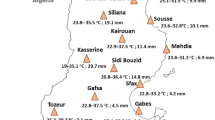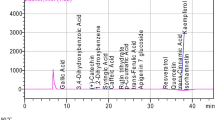Abstract
In view of the growing demand for vegetable oils and fats, currently exploration of some under-utilized and non-conventional oil seed crops is of great concern. This work presents data on the detailed physicochemical and antioxidant attributes of kapok (Ceiba pentandra Gaertn.) seed oil. The kapok seeds contained an appreciable amount of oil (27.5 %), protein (35.0 %) and fiber (19.0 %). The extracted kapok seed oil (KSO) had an iodine value of 101.8 g of I2/100 g of oil, a saponification value of 187 mg of KOH/g of oil), and unsaponifiable matter 0.83 %. KSO also showed a good oxidation state as indicated by the measurements of the peroxide value, conjugated dienes, conjugated trienes, para-anisidine and the induction period (Rancimat method). The tested oil showed a considerable amount of total phenolics (2.50 mg/100 g) and an appreciable free radical scavenging capacity. Gas liquid chromatographic analysis of fatty acids (FA) reveals that KSO mainly has linoleic acid (33.6 %) followed by oleic acid (23.4 %) and palmitic acid (22.4 %). Besides, a notable amount of cyclopropenoid fatty acids such as malvalic acid (9.1 %) and sterculic acid (2.8 %) was also detected. The FA composition of the tested oil was further verified by recording FTIR and NMR spectra. Among the oil phytosterols, analyzed by GC/GC–MS, β-sitosterol was found to be the principal component whereas RP-HPLC analysis showed the occurrence of γ-tocopherol (550 mg/kg) as the major tocopherol along with considerable amount of α-tocopherol (91 mg/kg) and δ-tocopherol (5.52 mg/kg). It can be concluded from the results of this comprehensive study that under-utilized kapok seeds are a potential feed stock for the production of a useful oil for edible and/or oleochemical applications.



Similar content being viewed by others
References
Akram HM, Iqbal MS, Nadeem MA, Ali A (2007) Agro-economics study on canola intercropping with sunflower. J Agric Res 45:81–85
Raziq S, Anwar F, Mehmood Z, Shahid SA, Nadeem R (2012) Characterization of seed oils from different varieties watermelon [Citrullus lanatus (Thunb.)] from Pakistan. Grasasy y Aceites 63(4):365–372
Cerchiara T, Chidichimo G, Ragusa MI, Belsito EL, Liguori A, Arioli A (2010) Characterization and utilization of Spanish broom (Spartium junceum L.) seed oil. Ind Crop Prod 31:423–426
Nehdi IA (2011) Characteristics and composition of Washingtonia filifera (Linden ex André) H. Wendl. seed and seed oil. Food Chem 126:197–202
Manzoor M, Anwar F, Ashraf M, Alkharfy KM (2012) Physico-chemical characteristics of seed oils extracted from different apricot (Prunus armeniaca L.) varieties from Pakistan. Grasas Aceites 63:193–201
Anwar F, Naseer R, Bhanger MI, Ashraf M, Talpur FN, Aladedunye FA (2008) Physico-chemical characteristics of citrus seeds and seed oils from Pakistan. J Am Oil Chem Soc 85:321–330
Parry J, Su L, Luther M, Zhou K, Yurawecz MP, Whittaker P, Yu L (2005) Fatty acid composition and antioxidant properties of cold-pressed marionberry, boysenberry, red raspberry, and blueberry seed oils. J Agric Food Chem 53:566–573
Zeven AC (1979) Kapok; Ceiba pentandra (Bombacaceae). In: Simmonds NW (ed) Evolution of Crop Plants. Longman, USA
Lotschert W, Beese G (1991)Collins guide to tropical plants – translated by Clive King. Williams Collins, Glasgow
Fong CH, Enoch (1988) Malaysian trees in colour. Art Printing Sdn. Bhd, Kuala Lumpur
Allen BM (1971) Some common trees of Malaysia and Singapore. Singapore Offset Printing, Singapore
Lim TT, Huang X (2007) Evaluation of kapok (Ceiba pentandra Gaertn.) as a natural hollow hydrophobic-oleophilic fibrous sorbent for oil spill cleanup. Chemosphere 66:955–963
Raju PK, Reiser R (1967) Inhibition of fatty acyl desaturase by cyclopropene fatty acids. J Biol Chem 242:379–384
Berry SK (1979) The characteristics of kapok (Ceiba pentandra Gaertn.) seed oil. Pertanika 2:1–4
Salimon J, Kadir KAA (2005) Fatty acid composition and physicochemical properties in Kekabu seed oil. Sains Malaysiana 34:117–120
Association of Official Analytical Chemists (AOAC) (1990) Official methods of analysis of Association of Official Analytical Chemists, 15th ed., AOAC Inc., Method 954.01, Arlington, VA
International Organization for Standardization (ISO) (1981) Animal feeding stuff determination of nitrogen and calculations of crude protein content. ISO, Geneva Standard No 5983
International Organization for Standardization (ISO) (1977) Oilseed residues determination for total ash. ISO, Geneva Standard No 749
American Oil Chemist’s Society (AOCS). Official and recommended practices of the American Oil Chemist’s Society, 5th edition, AOCS Press, Champaign
International Union of Pure and Applied Chemistry (IUPAC) (1987) In: Paquot C and Hautfenne A (eds), Standard methods for the analysis of oils, fats and derivatives. 7th revised and enlarged edition, Blackwell, London, UK
Anwar F, Bhanger MI, Kazi TG (2003) Relationship between Rancimat and active oxygen method values at varying temperatures for several oils and fats. J Am Oil Chem Soc 80:151–155
Christie WW (1993) Preparation of ester derivatives of fatty acids for chromatographic analysis. In: Christie WW (ed) Advances in lipid methodology, 2nd edn. Oily Press, Dundee
Wrolstad RE (2003) Analysis of tocopherols and tocotrienols. In: Wrolstad RE (ed) Current protocols in food analytical chemistry (CPFA). Wiley, New York
Anwar F, Przybylski R, Rudzinska M, Gruczynska E, Bain J (2008) Fatty acid, tocopherol and sterol compositions of Canadian prairie fruit seed lipids. J Am Oil Chem Soc 85:953–959
Latif S, Anwar F (2011) Aqueous enzymatic sesame oil and protein extraction. Food Chem 125:679–684
Pritchard JLR (1991) Analysis and properties of oilseeds. In: Rossell JB, Pritchard JLR (eds) Analysis of oilseeds, fats and fatty foods. Elsevier, New York, pp 39–102
Rossell JB. (1991). Vegetable oil and fats. In: Analysis of oilseeds, fats and fatty foods. (Eds.): JB Rossell, JLR Pritchard. Elsevier, New York, pp. 261–319
Anwar F, Latif S, Ashraf M (2006) Analytical characterization of hemp (Cannabis sativa) seed oil from different agro-ecological zones of Pakistan. J Am Oil Chem Soc 83:323–329
Pusod U, Okonogi S, Ampasavate C, Chansakaow S, Yotsawimonwat S (2011) Development of nanoemulsion lotion products from indigenous oil with antioxidant activity, Proceedings of PACCON (Pure and Applied Chemistry International Conference) 148–151
Latif S, Anwar F, Hussain AI, Mahmood S (2011) Aqueous enzymatic process for oil and protein extraction from Moringa oleifera seed. Eur J Lipid Sci Technol 113:1012–1018
Author information
Authors and Affiliations
Corresponding author
About this article
Cite this article
Anwar, F., Rashid, U., Shahid, S.A. et al. Physicochemical and Antioxidant Characteristics of Kapok (Ceiba pentandra Gaertn.) Seed Oil. J Am Oil Chem Soc 91, 1047–1054 (2014). https://doi.org/10.1007/s11746-014-2445-y
Received:
Revised:
Accepted:
Published:
Issue Date:
DOI: https://doi.org/10.1007/s11746-014-2445-y




